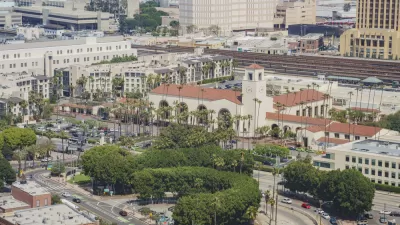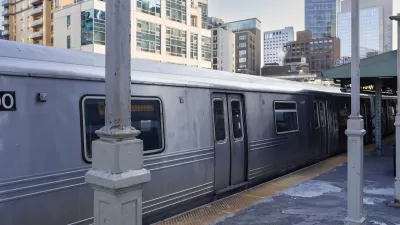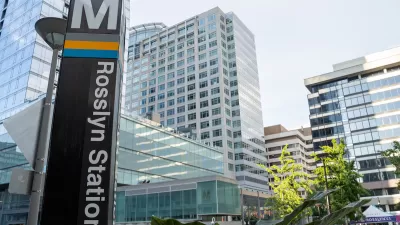The Los Angeles County Metropolitan Transportation Authority (Metro) is implementing a new vision for "transit-oriented communities."
To help achieve its new goal of developing transit-oriented communities, Metro recently revised the process by which it develops Metro-owned land, increasing its commitment to affordable housing, collaboration with local jurisdictions, and community engagement.
"TOC is a comprehensive look at how a rail station or a joint-development site at a rail station impacts a broader community context," Jenna Hornstock, who oversees Metro's Joint Development Program, explains in The Planning Report. "Within Joint Development, we’re moving beyond the goal of 'getting a project done on Metro-owned land.'"
On the ground, the new set of goals guide the development process from the pre-planning stages:
"For our joint development sites, we ask: What are the community development goals of that area? What kinds of amenities are needed in that community? What are the opportunities for active transportation connections at our site? How can the perimeter of the site link into investments we know might be coming for active transportation? How do we use that site to instigate and support further investment in the infrastructure?"
Working toward an enriched agenda, with more considerations, ambitions, and impacts, has required Metro to collaborate with more stakeholders. The agency is now developing closer partnerships with local municipalities to share information, expertise, and resources.
"With no redevelopment tax-increment available, we’re all going to have to get creative and bring something to the table," Hornstock says.
What Metro brings to the table is primarily land—as well as long-term investment in infrastructure, planning grants, and a sizable staff. Cities and municipalities can leverage local and federal dollars, and exercise control and flexibility over land-use regulations. Metro is also looking to newly created tools, like AB 2's Community Revitalization Investment Areas and Enhanced Infrastructure Financing Districts.
Fortunately, the benefits of this comprehensive work can also be multifold; if transit works to provide community amenities, amenities can encourage communities to use transit:
It all links back to creating more mobility options for communities and supporting public transit. The more we can center communities around public transit, through our joint-development sites and other targeted investments, the more people will get out of their cars and find other modes of transportation.
Hornstock also oversees Metro's Union Station Master Plan, which, likewise, entails collaboration with other agencies—specifically SCRIP and High-Speed Rail—to achieve co-benefits—in this case for bikes, pedestrians, rail, buses, and HSR. Read more on the changes coming to L.A.'s Union Station in The Planning Report.
FULL STORY: Metro’s Joint Development Goal: Transit Oriented Communities

Maui's Vacation Rental Debate Turns Ugly
Verbal attacks, misinformation campaigns and fistfights plague a high-stakes debate to convert thousands of vacation rentals into long-term housing.

Planetizen Federal Action Tracker
A weekly monitor of how Trump’s orders and actions are impacting planners and planning in America.

San Francisco Suspends Traffic Calming Amidst Record Deaths
Citing “a challenging fiscal landscape,” the city will cease the program on the heels of 42 traffic deaths, including 24 pedestrians.

Defunct Pittsburgh Power Plant to Become Residential Tower
A decommissioned steam heat plant will be redeveloped into almost 100 affordable housing units.

Trump Prompts Restructuring of Transportation Research Board in “Unprecedented Overreach”
The TRB has eliminated more than half of its committees including those focused on climate, equity, and cities.

Amtrak Rolls Out New Orleans to Alabama “Mardi Gras” Train
The new service will operate morning and evening departures between Mobile and New Orleans.
Urban Design for Planners 1: Software Tools
This six-course series explores essential urban design concepts using open source software and equips planners with the tools they need to participate fully in the urban design process.
Planning for Universal Design
Learn the tools for implementing Universal Design in planning regulations.
Heyer Gruel & Associates PA
JM Goldson LLC
Custer County Colorado
City of Camden Redevelopment Agency
City of Astoria
Transportation Research & Education Center (TREC) at Portland State University
Jefferson Parish Government
Camden Redevelopment Agency
City of Claremont





























